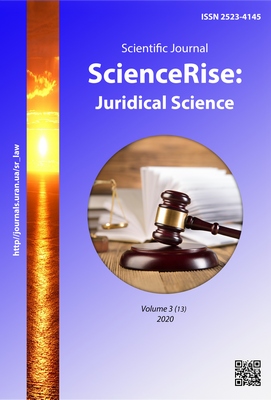The essence of negative incentives in law
DOI:
https://doi.org/10.15587/2523-4153.2020.213441Keywords:
stimulus, stimulation, legal stimulus, legal stimulation, positive stimulation, negative stimulation, law, state, restrictions, legal restrictionsAbstract
The article examines incentives in law, because legal incentives are a strong lever of motivational pressure, the most important means of educated modern human. It is emphasized. that legal incentives are an effective tool of public administration, a way to solve existing economic and social problems. It is determined, that the subject of legal incentives is the "own" interest of the subject.
The approaches of a number of researchers concerning the division of legal incentives into positive and negative are given. A comparison is made between legal restrictions and incentives in law. Criteria are given that separate legal incentives from legal restrictions. It is noted, that all legal means of coercion as incentives should be used in such a way that they can have a positive impact on a particular convict in the implementation of an individual program of correction, and on the activities as a whole. In the future, it is emphasized, that legal incentives as positive factors often include all legal means and in the case when they contribute to the goal of law - direct people's behavior in the right direction.
It is noted, that negative incentives are an integral part of maintaining law and order in the state, as it aims to influence a person, forcing him/her to do so by restricting his/her opportunities through coercive measures by the state. Negative incentives take on the role of restrictions, affect the subject by narrowing the scope of opportunities through "negative" legal motivation and coercive measures, while playing the role of a general regulatory legal instrument. At the same time, negative incentives are those significant levers on the part of the state that aim to prevent illegal behavior of a person and force him/her to commit lawful behavior, through the possibility of using state coercion or prosecution
References
- Kaliuzhnyi, R. A., Lapka, O. Ya., Pikulia, T. O. (2013). Pravovi stymuly v mekhanizmi pravovoho stymuliuvannia. Kyiv: «MP Lesia», 204. Available at: https://er.nau.edu.ua/bitstream/NAU/26642/1/Monograf_step4.pdf Last accessed: 02.10.2020
- Levin, V. O. (2006). Stimulirovanie v prave: teoreticheskie i prakticheskie aspekty. Nizhnii Novgorod, 27. Available at: http://lawtheses.com/jreader/178343/a?#?page=6 Last accessed: 02.10.2020
- Miroshnik, S. V. (2003). Teoriia pravovogo stimulirovaniia. Rostov-na-Donu, 40. Available at: http://lawtheses.com/jreader/93607/a?#?page=6 Last accessed: 02.10.2020
- Ivanova, E. V., Semenova, I. Iu. (2016). Pravovye stimuly i pravovye ogranicheniia v otechestvennom semeinom prave kak sovremennaia teoreticheskaia problema. Oeconomia et Jus, 2, 14–19. Available at: https://cyberleninka.ru/article/n/pravovye-stimuly-i-pravovye-ogranicheniya-v-otechestvennom-semeynom-prave-kak-sovremennaya-teoreticheskaya-problema/viewer Last accessed: 02.10.2020
- Miroshnik, S. V. (2003). Teoriia pravovogo stimulirovaniia. Rostov-na-Donu, 380. Available at: http://lawtheses.com/jreader/93607/d#?page=4 Last accessed: 02.10.2020
- Vediakhin, V. M. (1992). Pravovye stimuly: poniatiia, vidy. Pravovedenie, 1, 50–55.
- Smoliarova, M. L. (2017). Poniattia ta sutnist stymuliv u trudovomu pravi. Naukovyi visnyk Khersonskoho derzhavnoho universytetu. Seriia Yurydychni nauky, 5 (1), 163–166.
- Malko, A. V. (2004). Stimuly i ogranicheniia v prave. Moscow: Iurist, 250.
- Gluschenko, E. V., Zakharova, E. V., Tikhonravov, Iu. V. (1997). Teoriia upravleniia. Moscow: Vestnik, 332.
- Torgan, K. E. (1983). Pravovye stimuly nauchno-tekhnicheskogo progressa v proizvodstvennom obedinenii. Moscow: Iuridicheskaia literatura, 88.
- Tikhonravov, Iu. V. (1997). Osnovy filosofii prava. Moscow: Vestnik, 608.
- Ignatenkova, K. E. (2010). Ispolzovanie pozitivnykh i negativnykh norm-stimulov v pravovom regulirovanii. Sovremennoe pravo, 7, 15–17. Available at: https://www.sovremennoepravo.ru/m/articles/view/Использование-позитивных-и-негативных-норм-стимулов-в-правовом-регулировании-1 Last accessed: 02.10.2020
- Ohirok, S. S. (2000). Potreby i stymuly yak systemoutvoriuiuchi faktory rozvytku osobystosti (na materialakh pedahohichnoi spadshchyny A. S. Makarenka ta suchasnykh pedahohiv-novatoriv). Luhansk, 20.
- Demieva, A. G. (2015). Stimulirovanie kak metod pravovogo regulirovaniia otnoshenii s uchastiem predprinimatelei. Problemy sovremennoi iuridicheskoi nauki: aktualnye voprosy. Krasnoiarsk, 55–59. Available at: https://izron.ru/articles/iz-voprosov-okhvatyvaemykh-problemoy-sudebnykh-resheniy-vazhneyshee-teoreticheskoe-i-prakticheskoe-z/sektsiya-3-grazhdanskoe-pravo-predprinimatelskoe-pravo-semeynoe-pravo-mezhdunarodnoe-chastnoe-pravo-/stimulirovanie-kak-metod-pravovogo-regulirovaniya-otnosheniy-s-uchastiem-predprinimateley/ Last accessed: 02.10.2020
Downloads
Published
How to Cite
Issue
Section
License
Copyright (c) 2020 Viktor Lazariev

This work is licensed under a Creative Commons Attribution 4.0 International License.
Our journal abides by the Creative Commons CC BY copyright rights and permissions for open access journals.
Authors, who are published in this journal, agree to the following conditions:
1. The authors reserve the right to authorship of the work and pass the first publication right of this work to the journal under the terms of a Creative Commons CC BY, which allows others to freely distribute the published research with the obligatory reference to the authors of the original work and the first publication of the work in this journal.
2. The authors have the right to conclude separate supplement agreements that relate to non-exclusive work distribution in the form in which it has been published by the journal (for example, to upload the work to the online storage of the journal or publish it as part of a monograph), provided that the reference to the first publication of the work in this journal is included.









